I Probably Shouldn't Admit This About Something I Wrote, But I Accidentally Re-read Carnivore All The
I probably shouldn't admit this about something I wrote, but I accidentally re-read Carnivore all the time. I'll open it to look something up to reference in Gripped Tight and then start reading like "oh shit, this was good. oh dang i did that so true of me. oh wow i'd forgotten that part i love that jeez!" lol
More Posts from Lune-versatile and Others
Writing Tip!
An easy way to tell if you’re showing instead of telling is how much you’re using is/was. My English professor explained this to me a few semesters ago, and while he just wanted varied sentence structure in my papers, it also works very well for creative writing.
This isn’t to say that is and was are bad verbs, but rather that they are very basic and do not express anything beyond the fact that something exists. Sometimes, that’s all you need to know in a sentence, but often, the writer can make the story or the characters more engaging by explaining who someone is, what something is, where something is, when something is, why something is, or how something or someone is more powerfully by using one of a few tactics.
The first method is to use strong verbs. “Strong verbs” is a term that gets thrown around a lot, but a strong verb is simply a verb that explains what action is happening as clearly as possibly. For instance, when one “jumps” off the diving board, the reader doesn’t know how the person jumped, but the reader will be able to more clearly see the action if you write “she dove” or “he cannonballed” or “she belly-flopped.” Be aware of who is reading your writing and who the narrator is. In general, if your target demographic probably doesn’t know the word or if your narrator wouldn’t know the word, use a simpler, less precise verb and use adverbs to make it specific.
Another way is to show why the narrator was saying “it is/she was/there is” in the first place. Think of the is/was statement as the disease. You want your reader to guess the disease, so you start describing symptoms. For instance, “She is mourning her husband.” vs. “She stared at the empty seat at the table, unfazed by her mother’s repeated attempts to get her attention.” This way is more rambly than just swapping boring verbs for strong verbs, but it is a good way to show the narrator’s experience in life, the narrator’s biases, the narrator’s emotional state, etc.
One other way is to make the object of the sentence the subject instead. This just means that whatever “is/was” is now what the sentence is about. This is a simple fix in cases when the object is doing something in the sentence. Instead of “There was a ball rolling past her feet.” write “A ball rolled past her feet.”
Let me illustrate:
How you can use varied word choice to show who is being talked about:
Bland: Jason’s dad was standing in front of Jason.
Engaging: His dad loomed over him.
By using a stronger verb, the more hostile loomed, the reader gets a better idea of who Jason’s dad is and how Jason feels about him.
How you can use varied word choice to show who is talking:
Bland: Macy was sitting at the edge of her seat.
Engaging: Macy balanced very carefully at the very edge of the seat so her feet could touch the floor, because Macy was a very big girl now.
The POV character is a young girl at an age where she wants to be perceived as older than the height of chair legs and the lack of height of her own legs will let her be. She also refers unironically to herself as a big girl in her own thoughts, something grownups generally do not do. By expanding on the reason for the action instead of the action itself and with careful word choice, you can set the tone of the character and of the story.
How you can use varied word choice to show what something is:
Bland: That is a tree branch blowing against the window.
Still bland but better: A tree branch blew against the window.
Engaging: The branch smacked against the window.
This is an example of taking the object (the thing in the sentence that the verb is happening to) in this case “branch” and make it the subject. In the still bland but better version of the sentence, the fact that the tree branch is blowing against the window is obvious, but that doesn’t tell us anything about how the narrator feels about what the tree branch is doing. That tells us what, but it does not tell us what the character feels about this thing. Smacked is a more violent, sudden, startling verb that communicates suddenness, surprise, and unease.
How you can use varied word choice to show where something is:
Bland: The phone was on the far side of the nightstand.
Engaging: She flopped an arm blindly across the nightstand, but her fingers hit empty air just shy of the faint glow of her phone.
The engaging version of this sentence tells you more about the character’s mental state, fatigued, while also communicating where the phone is. Also, using a more descriptive word like flopped gives the reader a clearer mental image of what is physically happening in the scene.
How you can use varied word choice to show when something is set:
Bland: It was the early two thousands.
Engaging: Jana looked around the room and saw many a teenage male heinie, but not a belt among them.
Noting fashion trends, like sagging pants or hoop skirts, can reinforce the time period that you’re writing in and how the narrator fits or does not fit into that time period.
How you can use varied word choice to show when (what time) something is:
Bland: It was seven P.M. on a summer night.
Engaging: He watched the sun dip below the far reaches of the ocean as he wiped the sweat from his brow.
The engaging version of this sentence uses a few details to show about what time and when in the year this sentence takes place: it is sunset, so the exact time isn’t stated, but the rough time is implied; the ocean does exist at times of the year when humans aren’t on it as much (and here I though the entire state of Hawaii disappeared between September and April) but most readers will associate the beach with summer; and if the reader didn’t get the clue about the traditionally seasonal location, it is hot enough to make the main character sweat.
How you can use varied word choice to show why the narrator believes something:
Bland: Kai is a good friend.
Engaging: Kai held her hair away from her face as she threw up into the toilet bowl for the fourth time that night.
Anyone can say anything about anyone else, but the best way to get a reader to like a character, an idea, or a thing is to show them why they should like that thing. Instead of making bland moral claims like “Love is stronger than hate.” tell me how the Samaritan stopped to save the Jew, or how the enemies put aside their differences to protect what they care about. Instead of saying “He was scared of his dad.” show me the beer cans and the slurred speech, show me the belt falling and the voice yelling. Show the reader why.
How you can use varied word choice to show how something is:
Bland: The woman was looking at him.
Engaging: The woman ogled him.
Strong verbs again! Use strong verbs that are emotionally charged when you’re talking about emotionally charged situations! Being ogled is an uncomfortable sensation for the person being ogled, and it also shows disrespect on the part of the person ogling.
Keep in mind that these are guidelines! Sometimes is is the best word for the job, and don’t stress if you have a lot of is/was in your stories. Just because they’re bland doesn’t mean that sometimes you need bland verbs to communicate what you want to communicate. Still, you don’t want vagueness to be your crutch, either. Practice showing instead of telling when showing is more important, but have fun with it! Besides, you can always edit whatever you hate or are unsure of now sometime later.
Don’t sweat! Go write awesome papers and stories!
Drafting Your Creative Time: Your Guide to Planning a Year of Creative Writing
2024 is about to start. You’re going to venture into another year of writing incredible stories, but what will that practically look like? I feel more in charge of my creativity by planning rough writing schedules. Here’s how you can do the same without locking yourself into a too-strict calendar that leaves your writing spirit depleted.
Set One Writing Goal
Twelve months is a lot of time, but anyone can handle a single goal. Make the next year easy on yourself by picking one thing you want to accomplish (and let’s not make it “publish my novel” if you’re just starting the manuscript on January 1, given how it takes roughly 18 months of work after you get an agent) (and that can take a few weeks to a few years, depending on your querying experience!).
Try picking a manageable writing goal like these:
I will write 10 chapters of my novel.
I will make a collection of 5 short stories I write this year.
I will submit a short story to at least 3 contests this year.
I will publish one new work of fanfiction in the next 12 months.
I will write one short story in a new genre.
Publishing a book can be a long-term goal, but your 2024 goal should be easy to break down into manageable steps you can accomplish by yourself. You’ll be more likely to reach the finish line and work toward another goal.
Establish a Stress-Free Writing Schedule
Creativity comes and goes, but your writing will never get done if you don’t form some kind of schedule. Your upcoming year could look something like this:
I’ll write every Wednesday night between 7-7:30 p.m.
I’ll use voice-to-text to get my story-related thoughts on virtual paper for five minutes every morning before school.
I’ll do freestyle writing for five minutes on Mondays and Saturdays to keep my thoughts flowing, even if I don’t find more time to work on my story that week.
Your schedule should be realistic, which means it shouldn’t stress you out. Make it match your weekly and daily routine. When do you naturally feel most energized? When can you carve out ten minutes for your craft?
Remember, you can always (and should!) adjust this set schedule as time goes on. Your non-creative schedule most likely won’t look the same on January 1 as it will on December 31.
Save a Few Writing Prompts
You might have a few weeks here or there when you’re juggling life’s responsibilities and can’t get to your WIP. It happens to all of us!
When you’re busy, try answering a writing prompt in three sentences or less. Use your phone, a sticky pad, or whatever’s nearby. You never know if it’ll inspire you later when you’re free to write.
In the meantime, you’ll keep using the creative side of your brain so your writing abilities don’t feel so distant.
Check out these prompt apps if getting online isn’t your thing or takes too much time from your busy schedule!
Find a Writing Community
There are so many ways to build a writing community. Start a tumblr about it (guilty as charged) or join a Facebook group. Find an active Reddit thread about your favorite genre or join a Discord server with writers.
You don’t even need to start talking to others and making friends if it makes you anxious. Read what people are saying to get inspired by everyone. You’ll naturally join in when you get excited about something they’re discussing and keep creative writing at the front of your mind.
Read Lots of Books
I always feel more connected to my writing when I’m actively reading. Artists of any kind need a source of inspiration to keep their creativity flowing. Keep an actively growing To Be Read list with apps like Story Graph (a Goodreads-type app that isn’t owned by Amazon and gives so much more information about your curated reading history!).
Visit your local library if you don’t have the money for new books all the time (who does?). As you get inspired by what you read, you’ll also pick up skills from authors you admire or note things you don’t want to recreate. Study each story’s structure and character development. You’ll return to your WIPs with renewed passion.
Embrace the Scary Editing Stage
Your first draft is your thoughts and dreams poured out on paper. The editing stage is where you refine and re-write your work until it shines. Set aside specific time for editing after completing a first draft of any story. Even if your editing phase doesn’t take very long, working on line edits and developmental edits will make your work so much better.
It’s also a normal form of frustration for writers, but one that happens no matter where your writing goes (on fanfiction websites, short story contests, a literary agent’s desk, etc.).
Schedule Your Rest
Writing might feel like a natural hobby, but your brain and body still need to rest after periods of intense focus/work. Schedule rest periods into your daily or weekly calendar. It’s time to recharge in whatever ways best suit your body, like:
Sitting outside
Walking in a park
Reading
Sitting in a hot bath
Going to the movies
Sleeping in
Keep in mind that sometimes you’ll need more rest than others. Extend some self-compassion by checking in with your physical and mental energy frequently during the next year. If you take time to rest, you’ll be less likely to burn out creatively.
-----
This next year will be full of growth, challenges, and joys in your writing life. Embrace every second by resting and writing in new ways.
Tips for Build up the tension
Introduce a mysterious character or event that captures the reader's interest from the outset, like a protagonist receiving a cryptic message or stumbling upon a hidden artifact.
End a chapter with a sudden revelation or a character in peril, leaving readers eager to find out what happens next. For instance, a chapter ending with the sound of a gunshot but without revealing who fired it.
Drop hints about future events or conflicts throughout the story, such as a character experiencing recurring nightmares that seem to foretell danger.
Introduce friction between characters with opposing goals or values, leading to heated arguments or tense standoffs.
Use a narrator with a skewed perspective or hidden agenda, causing readers to question the accuracy of the events described.
Describe the setting in a way that evokes a sense of foreboding or unease, like a dark, abandoned mansion shrouded in mist.
Gradually unveil the protagonist's backstory or a central mystery piece by piece, keeping readers guessing and eager for more revelations.
Subvert genre conventions or tropes to keep readers guessing, such as portraying a seemingly trustworthy character as the ultimate villain.
Incorporate unexpected plot twists or betrayals that challenge the protagonist's assumptions and force them to adapt.
how can I make my writing more atmospheric?
How to Make Your Writing More Atmospheric
The key to making your writing more atmospheric is adding more description, and the key to good description is to create sensory descriptions by utilizing things that can be seen, heard, touched/felt, tasted, and smelled. For example, if your character is watching a building burn, you could describe the color of the flames, the sound of sirens or crackling fire, the smell of smoke, the taste of charred wood in the air, the heat emanating from the flames. You don't need to (and shouldn't) hit on all the senses in every description, but every time you need to describe something, consider it from your character's POV... what do they see, smell, hear, taste, etc., then choose a few that make the thing being described the most real to your reader. The following posts will also help:
How to Make Your Description More Vivid
Adding Description to Your Writing
Describing Character Appearance and Clothing
Horror by Darkness (general description advice)
Horror by Daylight (general description advice)
Adding Emotional Details to a Horror/Tragedy Scene
On creating a wiki for your worldbuilding
Do you have a lot of lore to keep track of? Whether you're an author, a Game Master, or simply someone who really really likes worldbuilding, this post is for you.
Here's a quick overview of what I'll be talking about:
Platforms people use to create personal wikis
Formats and organization systems you may find useful when creating your own wiki
A brief look at the actual content you might put in your wiki (I'm planning a more in-depth post on that later with more images and demos)
And because this is gonna be a long'un, I'm putting a read-more here! I'll also make downloadable epub and PDF versions of this post available for free on my Ko-Fi at some point in the future.
(I'm also planning to reblog with a list of links later on, but I want this initial post shows up in search)
Also now that you're here, I'm going to say this isn't, like, super comprehensive or anything. I'm just talking about stuff I know a little about or have experience with. Please feel free to reblog with additions and/or corrections as needed!
What is a wiki?
According to Wikipedia, "a wiki is a hypertext publication collaboratively edited and managed by its own audience, using a web browser."
In this case, you'll likely be the sole person making updates to your wiki. The web browser part is optional these days as well, as you'll soon see.
Platforms for creating wikis
Websites for creating worldbuilding wikis
WorldAnvil
This one is actually designed for people who want to create big worldbuilding wikis.
Pros: Worldbuilding prompts! Those are great. It's got a pretty comprehensive set of article types too.
Cons: Kind of expensive to upgrade for features like making your wiki private, and it does NOT work well with adblock turned on, so if you don't want to pay for a membership you'll get inundated with ads. I'm not a huge fan of the interface in general and a lot of it isn't intuitive, but I like what they're doing so I support them anyway.
---
Tiddlywiki/Tiddlyhost.com.
In addition to having a cat as its icon and also a silly name, each 'article' you create with this is called a 'tiddler' which makes me think of Chuck Tingle. I haven't used it much myself yet, but I did make an account and it seems pretty neat.
---
Miraheze
A community-hosted wiki platform that runs on MediaWiki (which is what Wikipedia runs off of).
Pros: It's not Fandom.com.
Cons: You have to request a wiki and can't just make it yourself, as far as I can tell. I haven't actually looked into this one as much.
---
Neocities
An option for if you want to go super oldschool and create a website using only basic html and hyperlinks (without the handy shortcuts of bbcode or Markdown). Monthly cost is $5 usd if you want to have more space and your own domain.
Pros: 100% control over your content.
Cons: Doesn't support PHP databases for wiki software, and can be fairly labour-intensive to update if you break a link or something.
---
Fandom.com
Unfortunately, this one is the top result you'll get when you look up how to make your own wiki. I'm only including it here to tell you to stay as far away from it as possible!!
Its staff are known to ban wiki creators from their own wikis and a bunch of other nonsense that I'm not getting into here.
Programs and apps/web apps for creating worldbuilding wikis
Obsidian.md
My personal favourite. I'm planning to make a whole post about how I use it in the near future as part of this article series.
It's a markdown-based application that you can get on just about any platform (Windows, MacOS, Linux, iOS, Android, etc) which is great. Obsidian is really easy to pick up and use and also has great themes and community plugins!
Best thing is, it's FREE and you only have to pay if you use their publishing service, which... I don't, so.
---
Notion
I've heard this one is pretty good too. Idk if it costs anything. It's another "second brain" style app (might be markdown also?) and I think it might do more than Obsidian, but I haven't checked it out much myself.
---
Microsoft Word/Google Docs etc.
...Or just about any word processor that lets you create internal hyperlinks. Word may work best due to the collapsible headings so it doesn't get too unwieldy, but *shrug* whatever floats your boat.
---
Excel/Google Sheets etc.
Or, again, any spreadsheet creator that lets you create internal hyperlinks.
I'd recommend having some basic spreadsheet knowledge before doing this. It could get complicated. Before I started using Obsidian, I was using Sheets to keep track of my glossary, notes about characters, and plot ideas.
Types of formatting & organization systems
There are as many organization systems as there are people who want to organize their stuff. Everybody needs something a little different! I find the ones that work best for me are systems that have a lot of customization options.
Here are a couple I know of.
Johnny Decimal
This system is absurdly simple in its concept and yet so versatile. From their website (it's just johnnydecimal dot com but I'll link it in a reblog later):
Take everything you need to organise and sort it in to, at most, ten large buckets.
Make sure the buckets are unambiguously different.
Put a label on each bucket.
Their website has a better explanation than I can give in this post, but I'll sum up the appeal of this system as quoted from their site: "There's only one place anything can ever be."
Usefully, part of this method is creating a directory for the rest of the system.
So if you're like me and tend to shove things wherever only to lose track of it later, this is a great system—especially when used in conjunction with the Zettelkasten Method (see below).
---
Zettelkasten Method
Originally devised as an extensive paper-based knowledge management system, Zettelkasten is meant to easily add new entries to a knowledge base while giving each one a unique ID for easy 'linking.'
The creator of this method said 'it is not important where you place the note, as long as you can link to it.'
As with the Johnny Decimal system, I can't explain it super succinctly (nor can the website, if I'm being honest), so I'll include a link in a future reblog for a video that gave me an excellent run-down of the basics.
Setting up your own system
An organization system is only useful if you can actually, y'know, use it.
It can be fun to set up a super-detailed organization system with predetermined categories for everything, but is it easy for you to use? How will you navigate it?
Making decisions
There will be a lot of decisions to make as you set up your system. The only set-in-stone rule I follow is... don't set anything in stone. It's okay if you decide something that doesn't work later on.
Figuring out your categories
My advice: go fairly broad. You can always sub-categorize. I'm going to go over my own wikis for Athenaeum and Rocket Boosters in detail in a later post, but here are the starting top-level categories I'd recommend for worldbuilders:
A meta category for notes about your database, templates, and any relevant research you've done.
Characters, including main characters, minor characters, and important figures
Worldbuilding
In the last category, which is the main reason for the existence of my wiki, I might have:
Culture
History
Locations
Organizations
Lore (if relevant)
Technology
Transportation
I'll go over the nuances of these 'main' subcategories in that future post I mentioned. In other words, the stuff that actually goes in those categories!
Determining the importance and relevance of worldbuilding elements
You'll need to figure out whether a topic is complex enough to deserve its own entry, or if it should be a sub-heading under another entry. It's okay if you decide on both! I have short subheadings under some entries that amount to "see [link to main entry on that topic]."
I've also decided to expand subheadings into their own topics, and I've removed topics as their own entry and shoved them under subheadings. I do this a lot, in fact! So it's okay if you don't know.
Templates
Will you be creating several of one type of entry?
Individual character profiles
Towns and cities
Factions
(to name a few)
It might be handy to figure out the basic types of information you'll need about each of those things and create a template for them.
A character template might have spaces for the basics, such as name, role, age, and so on.
Some characters will have a lot more information, and some might have even less than what your template dictates! And that's fine.
A word of warning about using system-creation as procrastination
Creating a wiki can be a daunting task. You might decide it's not for you, and that's okay. But you might also decide to go headlong into the process and work on every minute detail, and that is also okay, but.
But.
Beware of using your wiki as an excuse to procrastinate your actual writing/session preparation. Yes, use it to keep track of all the lore you've injected into your manuscript/campaign/whatever, just make sure it stays in its place as a companion to your main project rather than becoming your main project.
How formal should your entries be?
Honestly this one's entirely up to you. I have a mix. Some entries are written like Wikipedia entries with a thorough explanation of the topic with proper punctuation and formatting, while others are simply bullet-point lists of thoughts and ideas that I can return to at a later date.
What methods do you use to keep track of your lore and worldbuilding? Let me know in a reblog or comment!
And please make sure to check the notes. I'll be reblogging with links, and then reblogging that reblog to make sure they're, y'know, actually visible in the notes.
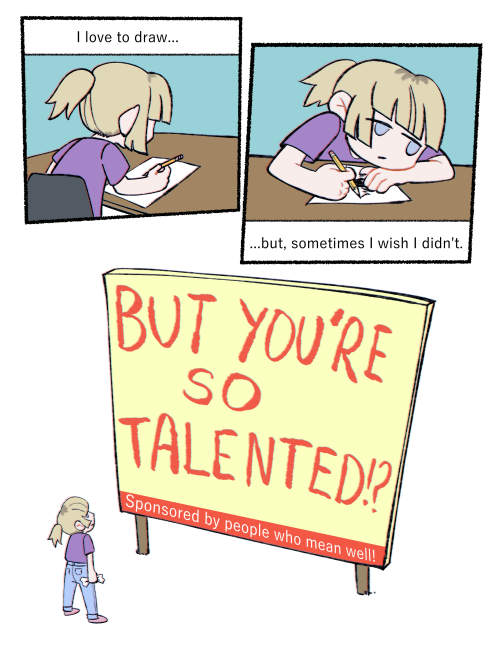
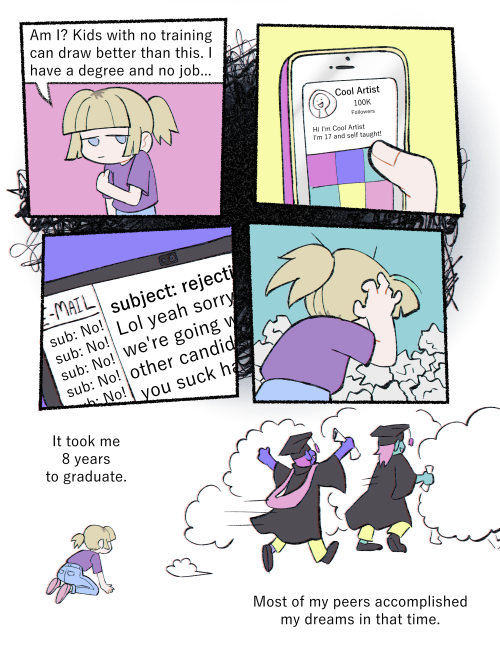
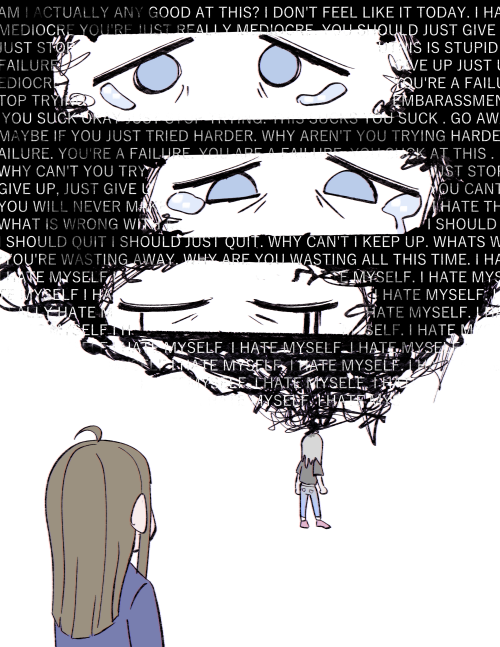
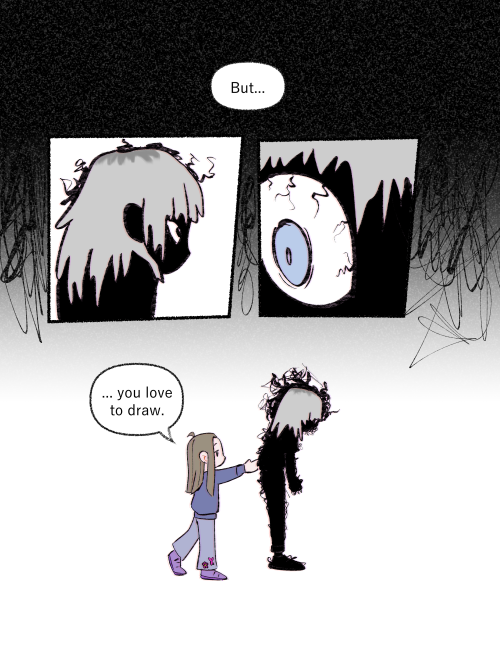
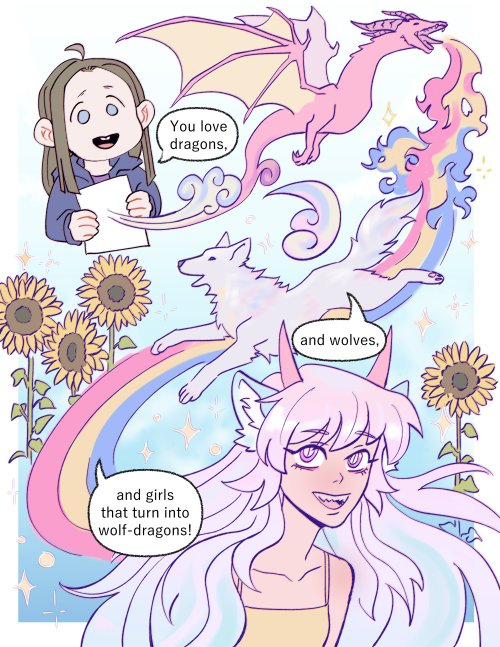
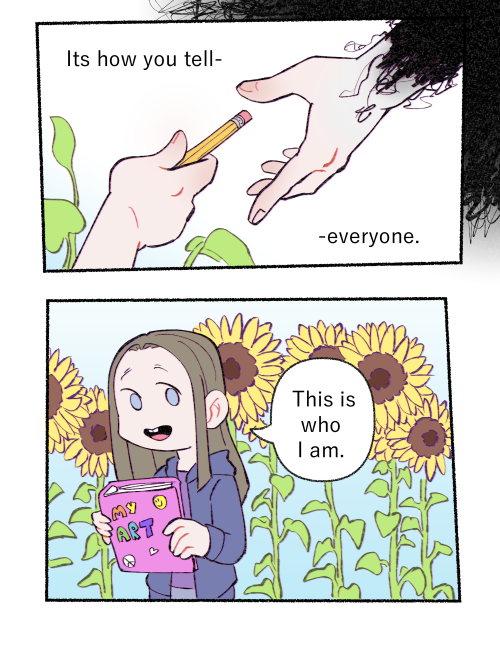

A comic to try and sort through some difficult feelings about being an artist and a reminder to not forget who you are.
How to Write a Death Scene
So, you want to write a death scene that hits your readers hard, right? Something that sticks with them, makes them feel something real?
First, give the death meaning. You can’t just toss in a death for the shock factor and call it a day. Even if it’s sudden or unexpected, the death has to matter to the story. Think about how it changes things for the characters who survive. Does it mess with their relationships? Their goals? Make sure this moment sends ripples through the rest of your plot. It’s gotta affect everything that happens after, like an emotional earthquake.
Then, think about timing. You don’t want to drop a death scene at the wrong moment and ruin the vibe. If it’s part of a big heroic moment or a heartbreaking loss in the middle of the story, it should feel earned. The timing of the death decides how your readers will react, whether they feel relief, gut-wrenching sorrow, or are totally blindsided. The right moment makes all the difference.
Next up, focus on the characters’ emotions. Here’s the thing, it's not always the actual death that makes a reader cry, it's how everyone feels about it. How do the characters react? Is the person dying scared, or are they at peace? Are the people around them in shock, angry, or just completely destroyed? You need to dive deep into these emotions, because that’s where your reader connects.
Make sure to use sensory details to pull readers into the scene. What does it feel like? The sound of their breathing, the stillness when they’re gone, the way everything feels heavy and wrong. Little details make the death feel real and personal, like the reader is right there with the characters, feeling the weight of the moment.
If your character has the chance, give them some final words or actions. What they say or do in those last seconds can really hit hard. Maybe they share a piece of advice, ask for forgiveness, or try to comfort the people around them. Even a simple gesture, a smile, a touch, a last look can leave a lasting impression. This is your last chance to show who this character was, so make it count.
Finally, don’t just stop when the character dies. The aftermath is just as important. How do the survivors deal with it? Does your main character fall apart, or do they find a new sense of purpose? Are there regrets? Peace? Whatever happens next should be shaped by the death, like a shadow that never quite goes away. Let your characters carry that weight as they move forward.
For questions or feedback on writing materials, please send me an email Luna-azzurra@outlook.com ✍🏻
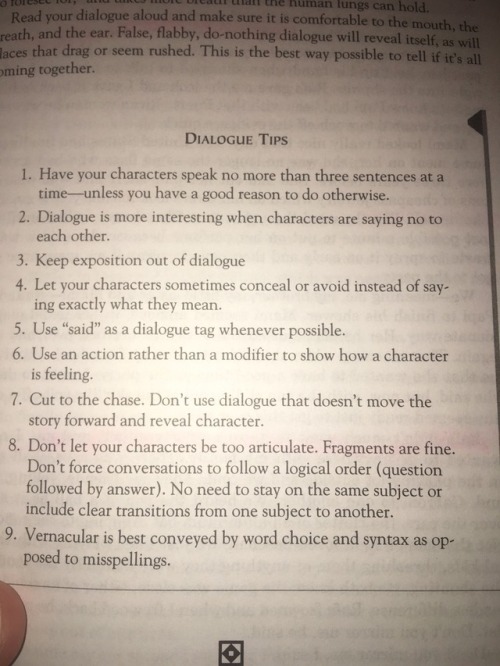
So I just started my short story writing class! These are dialogue tips from Janet Burroway’s Writing Fiction: A Guide to Narrative Craft

Tips for writing an essay with executive dysfunction: do this.
Write out bits and pieces of the essay. When you get to a part you can’t/”don’t want to” write, put it in bold brackets. Get as much done as you can and come back in a half an hour or so!
If the executive function is still bothering you, take it one bracket at a time. Don’t delete the bracket until you’re done “filling it in,” so to speak. If you need to take more breaks or hop to the next bracket, you can do that too! Similarly, if you have a thought you want to get down but you aren’t sure how to word it, put it in bold brackets as well!
It may not “cure” the executive dysfunction or procrastination problems, but it makes writing the essay more like putting shapes in holes of the same shape. It can be a pain, but the process is a bit more streamlined and user-friendly.
I know this may not work for everyone, but as someone who has really bad executive dysfunction and problems focusing (thank you, ADHD!) this works REALLY well for me! I hope by sharing it it can help other people (with and without executive dysfunction/adhd) too! o/




Read that marimos can get sick from receiving too much light, but this man of sunshine is only making them love sick.
-
 bakashisensei liked this · 1 year ago
bakashisensei liked this · 1 year ago -
 sarada-is-back reblogged this · 1 year ago
sarada-is-back reblogged this · 1 year ago -
 kixngiggles liked this · 2 years ago
kixngiggles liked this · 2 years ago -
 theworldsforgottenboy liked this · 2 years ago
theworldsforgottenboy liked this · 2 years ago -
 hot-elf liked this · 2 years ago
hot-elf liked this · 2 years ago -
 better-name liked this · 2 years ago
better-name liked this · 2 years ago -
 lune-versatile reblogged this · 2 years ago
lune-versatile reblogged this · 2 years ago -
 pissy-lissy liked this · 2 years ago
pissy-lissy liked this · 2 years ago -
 chmobian reblogged this · 2 years ago
chmobian reblogged this · 2 years ago -
 niche-pastiche reblogged this · 2 years ago
niche-pastiche reblogged this · 2 years ago -
 niche-pastiche liked this · 2 years ago
niche-pastiche liked this · 2 years ago -
 sirikenobilegends reblogged this · 2 years ago
sirikenobilegends reblogged this · 2 years ago -
 sirikenobilegends liked this · 2 years ago
sirikenobilegends liked this · 2 years ago -
 wren-again liked this · 2 years ago
wren-again liked this · 2 years ago -
 rauko-is-a-free-elf reblogged this · 2 years ago
rauko-is-a-free-elf reblogged this · 2 years ago -
 rauko-is-a-free-elf reblogged this · 2 years ago
rauko-is-a-free-elf reblogged this · 2 years ago -
 rippingyarn liked this · 2 years ago
rippingyarn liked this · 2 years ago -
 dei2dei liked this · 2 years ago
dei2dei liked this · 2 years ago -
 mrshyrockstar reblogged this · 2 years ago
mrshyrockstar reblogged this · 2 years ago -
 mrshyrockstar liked this · 2 years ago
mrshyrockstar liked this · 2 years ago -
 quwarichi liked this · 2 years ago
quwarichi liked this · 2 years ago -
 binkmoi liked this · 2 years ago
binkmoi liked this · 2 years ago -
 inlovewelive-inlovewedie liked this · 2 years ago
inlovewelive-inlovewedie liked this · 2 years ago -
 lune-versatile liked this · 2 years ago
lune-versatile liked this · 2 years ago -
 ltleflrt reblogged this · 2 years ago
ltleflrt reblogged this · 2 years ago -
 doctorprofessorsong reblogged this · 2 years ago
doctorprofessorsong reblogged this · 2 years ago -
 slytherkins reblogged this · 2 years ago
slytherkins reblogged this · 2 years ago -
 slytherkins liked this · 2 years ago
slytherkins liked this · 2 years ago -
 jemmalaine liked this · 2 years ago
jemmalaine liked this · 2 years ago -
 doctorprofessorsong liked this · 2 years ago
doctorprofessorsong liked this · 2 years ago -
 rauko-is-a-free-elf reblogged this · 2 years ago
rauko-is-a-free-elf reblogged this · 2 years ago -
 rauko-is-a-free-elf reblogged this · 2 years ago
rauko-is-a-free-elf reblogged this · 2 years ago
